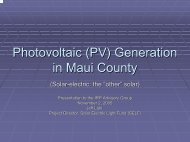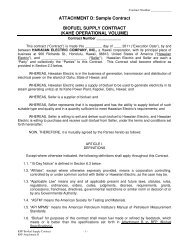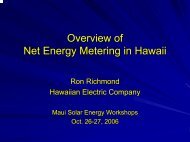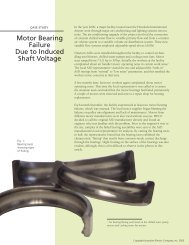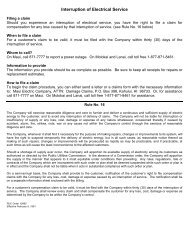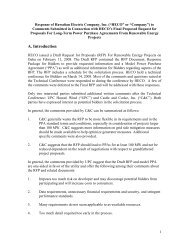Focus on Safety: GFCIs & AFCIsVarious Types ofGround-Fault Circuit-InterruptersThe ground-fault circuit-interrupters(GFCIs) and arc-fault circuit-interrupters (AFCIs) are two differentelectrical devices th<strong>at</strong> serve distinctpurposes. A GFCI is designed toprevent electrical shock. It has beenestim<strong>at</strong>ed th<strong>at</strong> if GFCIs are installed inhousehold branch circuits, <strong>the</strong>y couldprevent about two-thirds of <strong>the</strong>approxim<strong>at</strong>ely 300 accidentalelectrocutions th<strong>at</strong> happen in andaround <strong>the</strong> home each year. 1Likewise, AFCIs could save lives as wellas prevent property loss through <strong>the</strong>iruse and install<strong>at</strong>ion. In this article wewill discuss:• How GFCIs work and why <strong>the</strong>y areimportant• How AFCIs work and why <strong>the</strong>y areimportant• Code issues concerning GFCIs andAFCIs1www.cpsc.gov/cpscpub/pubs/99.html, ConsumerProduct Safety Commission, GFCIs Fact Sheet, 1996.2Ibid.Ground-Fault Circuit-Interrupters (GFCIs)A GFCI is a device th<strong>at</strong> interrupts an electrical circuit when a ground-faultis detected. It is specifically designed to prevent electric shock when aperson <strong>com</strong>es into contact with an electrically energized part. The deviceis only applicable for 120-volt, single-phase circuits. The GFCI oper<strong>at</strong>es by<strong>com</strong>paring <strong>the</strong> current between <strong>the</strong> hot p<strong>at</strong>h to <strong>the</strong> load (an appliance orlight, for example) and <strong>the</strong> neutral or return p<strong>at</strong>h. If an imbalance as littleas 5 milliamps exists for a period as short as 2 cycles (33 milliseconds), <strong>the</strong>device will trip <strong>the</strong> circuit. A current imbalance condition between <strong>the</strong> hotand neutral p<strong>at</strong>h indic<strong>at</strong>es a ground fault wherein current is somehowbeing diverted to a ground p<strong>at</strong>h. 2 An example of a shock hazard conditioninvolving a ground fault would be if someone were standing barefoot ona wet concrete floor and <strong>com</strong>ing into contact with an extension cord withbroken insul<strong>at</strong>ion th<strong>at</strong> exposing bare live wire. As one can surmise fromthis example, a GFCI <strong>at</strong> <strong>the</strong> electric receptacle where <strong>the</strong> cord is plugged incould be lifesaving. For older homes with 2-wire 125-volt receptacles, <strong>the</strong>install<strong>at</strong>ion of a GFCI receptacle or plug-in module will still protect againstground-faults.GFCIs are available as ei<strong>the</strong>r receptacles (<strong>the</strong>y are now required by code inb<strong>at</strong>hrooms, kitchens, basements, garages, and o<strong>the</strong>r places where w<strong>at</strong>ermay be present), plug–in modules for use with power tools, and part of <strong>the</strong>cord-plug <strong>com</strong>bin<strong>at</strong>ion of certain appliance such as hair dryers and circuitbreakers. GFCIs include test/reset pushbuttons and <strong>the</strong>se devices should betested after install<strong>at</strong>ion and monthly according to Underwriters Labor<strong>at</strong>ory.6
Code Issues Concerning GFCIs and AFCIsArc-Fault Circuit-Interrupters(AFCIs)An AFCI is a device th<strong>at</strong> interrupts an electricalcircuit when an arcing fault is detected. Itis specifically designed to prevent a fire whenan arcing current is detected. The deviceis only applicable for 120-volt, single-phasecircuits. The device works by tripping <strong>the</strong>protected circuit when a waveform typical ofan arc-fault current is detected. It can distinguishbetween inrush current, arcing currentwhen a switch is in oper<strong>at</strong>ion, and <strong>the</strong> kindof unintended arcing current th<strong>at</strong> can posea fire hazard. These types of hazardous arcscan occur <strong>at</strong> loose connections and termin<strong>at</strong>ionsor where wire insul<strong>at</strong>ion has be<strong>com</strong>edamaged. 3AFCIs are available as circuit breakers and alsoinclude a test pushbutton. As with GFCIs,AFCIs should be tested after <strong>the</strong>y are installedas well as once per month. Combin<strong>at</strong>ionGFCI-AFCI circuit breakers are also available. 4Arc-Fault Circuit-Interrupter Circuit BreakersMost municipalities, including Hawai’i, require th<strong>at</strong> <strong>the</strong> install<strong>at</strong>ion of electricalsystems within residential and <strong>com</strong>mercial buildings follow N<strong>at</strong>ionalElectric Code (NEC) requirements. Article 210 of <strong>the</strong> NEC governs <strong>the</strong>requirements for GFCI and AFCI applic<strong>at</strong>ions as <strong>the</strong>y apply to branch circuitprotection.Section 210.8 of <strong>the</strong> NEC - Ground-Fault Circuit-Interrupter Protectionfor Personnel - covers <strong>the</strong> GFCI requirements for residential dwelling unitsand <strong>com</strong>mercial buildings. Section 210.8 (A) lists <strong>the</strong> specific loc<strong>at</strong>ionsin dwelling units where GFCI branch circuit protection is required. Theseloc<strong>at</strong>ions include b<strong>at</strong>hrooms, garages, outdoors, crawl spaces <strong>at</strong> or belowgrade, unfinished basements, kitchens, areas around laundry and wet barsinks, and bo<strong>at</strong> houses. Section 210.8 (B) lists <strong>the</strong> specific loc<strong>at</strong>ions in<strong>com</strong>mercial buildings where GFCI branch circuit protection is required.These loc<strong>at</strong>ions include b<strong>at</strong>hrooms, <strong>com</strong>mercial and institutional kitchens,rooftops, and outdoors in public places. These requirements apply tosingle-phase 125-volt receptacles r<strong>at</strong>ed <strong>at</strong> 15 amps or 20 amps. 5Section 210.12 of <strong>the</strong> NEC - Arc-Fault Circuit-Interrupter Protection – covers<strong>the</strong> AFCI requirements for dwelling unit bedrooms, guest rooms andguest suites. These requirements apply to single-phase 120-volt branchcircuits r<strong>at</strong>ed <strong>at</strong> 15 amps or 20 amps. 6 AFCIs are required for bedroombranch circuits in new residential construction effective January 1, 2002.As of January 1, 2008 <strong>the</strong> NEC mand<strong>at</strong>es th<strong>at</strong> <strong>the</strong> “branch circuits supplyingoutlets installed in dwelling unit family rooms, dining rooms, livingrooms, parlors, libraries, dens, bedrooms, sun rooms, recre<strong>at</strong>ion rooms,closets, hallways, or similar rooms or areas shall be protected by a listedarc-fault circuit-interrupter, <strong>com</strong>bin<strong>at</strong>ion-type, installed to provide protectionof <strong>the</strong> branch circuit.” 7In addition to permanent install<strong>at</strong>ion requirements for GFCIs, <strong>the</strong>re are occup<strong>at</strong>ionalsafety requirements governing <strong>the</strong> use of GFCIs. OSHA Regul<strong>at</strong>ions(Standards - 29 CFR) Section 1926.404(b)(1) mand<strong>at</strong>es GFCI protectionof single-phase 120-volt 15 amps and 20 amps receptacle outlets <strong>at</strong>construction sites.Hawaii Administr<strong>at</strong>ive Rules Title 12 Subtitle 8 (Division of Occup<strong>at</strong>ionalSafety and Health) Part 2 Chapter 89.1 (Electrical) Section1910.304(b)(3)(i) covers GFCI branch circuit protection.3www.nfpa.org, N<strong>at</strong>ional Fire Protection Associ<strong>at</strong>ion,Electrical Circuit-Interrupters, September2007.4www.cpsc.gov/CPSCPUB/PUBS/afcifac8.pdf,Consumer Product Safety Commission, Arc-FaultCircuit-Interrupter (AFCI) Fact Sheet, January2001.So when it <strong>com</strong>es to safety and fire prevention think of GFCIs and AFCIs!5N<strong>at</strong>ional Electrical Code Committee, NFPA 70 N<strong>at</strong>ional Electrical Code 2005 Edition,N<strong>at</strong>ional Fire Protection Associ<strong>at</strong>ion, 2004.6Ibid.7www.afcisafety.org/codes.html, N<strong>at</strong>ional Electrical Manufacturers Associ<strong>at</strong>ion(NEMA), Arc-Fault Breaker Safety – Codes and Standards – 2008 NEC AFCI CodeLanguage.7



